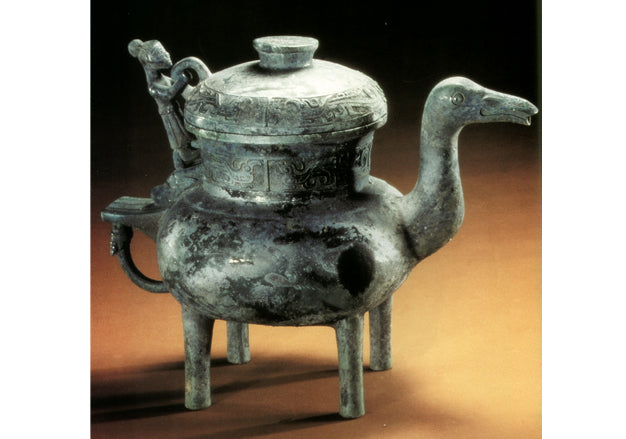
Bronze tripod with creeping geese

The “Crawling Goose” Bronze He [1] is a bronze wine vessel from the Western Zhou Dynasty. It is 25.2 cm tall, 31.8 cm long from spout to tail, 17.2 cm wide, and 14.3 cm in diameter. It weighs 3,550 g and has a capacity of 2,125 ml. It was unearthed in 1988 from the Ying State Cemetery in Pingdingshan, Henan Province. It is now in the collection of the Henan Museum.
The body of the “Crawling Goose” Bronze He is in the shape of a goose, with a round mouth opening in the middle of the back, open outside, with a slanted square lip, a high collar and a rounded rectangular flat body. The goose’s neck is curved and raised, its head is raised and looking forward, its eyes are wide open, and its flat mouth is slightly open, forming a natural spout. The goose’s tail has a handle in the shape of a dragon head that curls up and rises, and four pillar-shaped feet are attached under the flat belly. There is a small-mouthed lid on the mouth of the vessel, which is slightly raised. In the middle, there is a thick handle on the top and thin on the bottom as the lid button. The handle is decorated with curled bird patterns, and the edge of the lid is decorated with long bird patterns without tails. It is connected to the vessel by a human-shaped chain link, and is connected to a round-carved bronze man standing on the goose tail. This person holds the ring button on the lid with both hands, and there is a crossbeam between his feet, which connects with the ring button on the top of the relief bull head decoration on the goose tail. The bronze man has a vertical bun, which is tied high on the top of his head. The hair is fine and neat, the face is thin, the facial features are delicate, the upper body is naked, the lower body is wearing a ten-pleated skirt, the waist is decorated with a leather belt with continuous diamond patterns, and the feet are wearing shallow boots. The whole vessel is exquisite and dignified, and beautiful.
Figure 1 Part of the "Crawling" Goose Bronze He
The "Crawling" Goose Bronze He has an inscription of 5 lines and 44 characters inside the lid: Only in April, the tyrant Wushen was born, crawling to Di. Qing (Xing) Gong Shi (envoy) Si Shi (envoy) Mao Zeng (presented) Pu Yu (with) Jian (bundle) of deer, two pieces of leather, and one equal amount of red gold. Pu dared to say goodbye to Yang Gong and used Zha (made) a precious Yi (traditional Chinese vessel) for eternal use.
Figure 2 Inscription and rubbings inside the lid of the “Pu” goose bronze tripod
Scholars are still divided on whether the inscription reflects the historical fact that the Zhou royal family sent envoys to ask the ministers of the princes or that the princes sent envoys to communicate with each other. The main issue is the identification of Qing Gong in the inscription. Scholars such as Wang Longzheng, the excavator, believe [2] that Qing Gong is Xing Gong, the king of Xing State. The inscription records that an envoy from the Ying State named Pu went to Xing State in the Xingtai area of Hebei Province for a normal diplomatic visit and was warmly received by the king of Xing State. When Pu was about to return home after his visit, the king of Xing State sent the minister in charge of foreign affairs to present Pu with 30 jin of red copper, a deerskin garment, and a leather apron. After Pu returned to Ying State, he used these copper materials to make this bronze vessel to commemorate his successful visit to Xing State. Therefore, the inscription on this vessel reflects the routine betrothal gifts between the vassal states. The Zhou Li (Book of Zhou) states: "In all diplomatic relations between the princes, there are annual greetings, courtships, and visits to each other." The Zhou Li (Book of Zhou) states: "The jade, ... From the perspective of shape, the shape of its mouth, the collar under the mouth and the lid are similar to those of the Changsi Li from the period of King Mu; from the perspective of decoration, the long-tailed phoenix pattern belongs to the III3 type of bird pattern classified by Mr. Chen Gongrou and Mr. Zhang Changshou, and its age is also equivalent to the period of King Mu; from the perspective of the inscription, the font is the Yuzhu style popular in the middle of the Western Zhou Dynasty. The academic community generally believes that the Puhe was a vessel from the time of King Mu of the Western Zhou Dynasty.


![8.3"China Shang Dynasty,Bronze wine cup [Fuhao Jue cup][妇好爵杯]](http://bronzc.com/cdn/shop/files/4ee0482982cfa89bb4d1cff3333a55e6_e3ca0b86-22fc-497d-9afd-578c551225a3-2.jpg?v=1733986652&width=533)

![12.8" China Ming Dynasty, Phoenix-patterned bronze vase[Ming Wanli Phoenix-patterned vase][明万历凤纹瓶]](http://bronzc.com/cdn/shop/files/4ee0482982cfa89bb4d1cff3333a55e6_a516991b-2bb9-4b2f-a2b6-4354129d006c.jpg?v=1733986953&width=533)

![14.6" China Eastern Han Dynasty Bronze vessel in the shape of a flying horse,Also known as bronze galloping horse[Horse Stepping on Flying Swallow][马踏飞燕]](http://bronzc.com/cdn/shop/files/4ee0482982cfa89bb4d1cff3333a55e6_aa3fbeb8-e08b-4a44-929a-13411ca8fb17-2.jpg?v=1733987211&width=533)

![5.9"China Tang Dynasty, Bronze of a walking dragon[Tang Walking Dragon][唐走龙]](http://bronzc.com/cdn/shop/files/2_8cb416b9-ebbd-4fe2-a905-b9277f820c16.png?v=1731488701&width=533)
